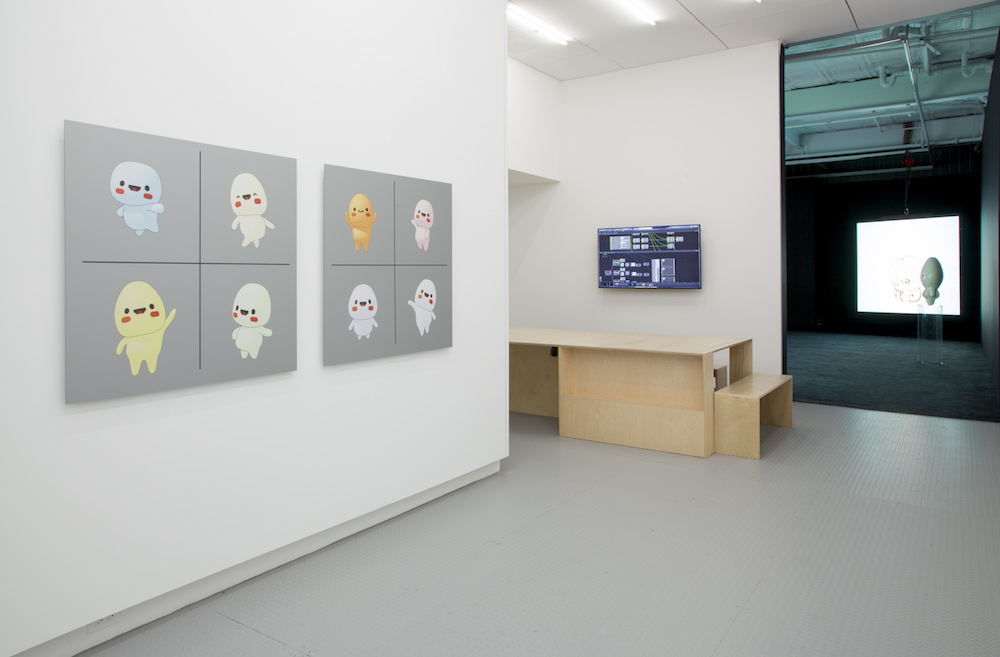Ed Fornieles: The Finiliar
by Elliot Mickleburgh
After reading through the headlines of your local newspaper, do you ever curiously flip to the business section and puzzle through the jargon found on those pages? The articles themselves are intelligible enough—tech startups are bought and sold, American pharmaceutical corporations are contemplating tax shelters in the Republic of Ireland, Wall Street seems forever straddled on the threshold between the writ and spirit of the law. Read through to the back pages though, and you will find yourself buried in the more abstract data of market gauges: lists of percentages and ratios, the +/– symbols, line charts, bar charts, yield curves, numbers, numbers, numbers. To the uninitiated, these figures are almost entirely meaningless. Reading them can actually make us feel despondent, ashamed of our ignorance. We might even come to wonder why this information is even distributed in the admittedly sluggish medium of print. Does the global economy not ebb and flow faster than a newspaper can usefully record?

The Finiliar, Ed Fornieles’ recent exhibition at New York’s Arsenal Contemporary, contemplates the challenges inherent in tracking, visualizing, and understanding market data. Developed over the course of a residency at Arsenal Montréal, the central subject of the exhibition is a mawkish cartoon character that the artist has dubbed the ‘Finiliar.’ One of two press releases for the show describes these Tamagotchi-esque creatures as such: “[a] digital entity feeding off data sets produced by companies, currencies, and other large institutions, using a cute facial interface to elicit a sense of emotional attachment within the viewer.” The real labor of Fornieles’ exhibition appears to be less concerned about creating individual art objects, and rather more focused on the production of this concept-cum-technology-cum-product.

Indeed, the exhibition design hints at the calculated quality of flashiness one would find at booth in a technology trade show. The viewer first sees images of the Finiliars depicted in inkjet prints on dibond before passing the gallery’s front desk, where patrons may purchase office bric-a-brac adorned with the Finiliar’s cherubic countenance. The main space of the gallery, theatrically furnished with black walls and carpets, contains glossy sculptures of Finiliars alongside LED monitors, showing these animated digital entities in action: cavorting, sobbing, and even vomiting to respective data feeds of real-time fluctuations in the Canadian dollar, British Pound Sterling, and the cryptocurrency Ethereum (an open-source, blockchain-based software project whose public crowdsale was bought as either a value token, “ether,” or in digital currency as a “bitcoin”). In the rear of the gallery is a single-channel video work that operates as either an in-depth explanation of (or advertisement for) the Finiliar; the context shifts depending on what audio the viewer hears over the projection. The pace and experience of the show is as such: our attention is first captured by aesthetically pleasing, but essentially non-functional, images of Finiliars, maintained by the offering of what amounts to trade show swag, assaulted by the spectacle of seeing the Finiliars fulfilling their function, and finally relieved by a certain type of debriefing of these elements.

The trade show encounter is defined by maximal entertainment—we are left curious as to whether all the hype was meaningful, or just shiny visual fodder shrouding a vapid idea. Thankfully, The Finiliar is not a CES booth, but an art exhibition, and what defines the narrative beneath the surface of these digital cutie-pies is far from insipid. Fornieles’ exhibition carves out a niche for critically responding to how we interact with large abstract sets of information, calling into question the media that communicate this information to us.
While the real-time nature of works like Dunop (British Pound Sterling, £) provides a workaround to the slow pace of printed market gauges, The Finiliar presses on several other interesting challenges in interpreting economic data. For example, we can presume that when a Finiliar flashes us a radiant smile from its LED corral, the value of a given currency has increased. But by how much did it increase? Did Ethereum become more valuable at the expense of other circulating cryptocurrencies? Could there even be holistic consequences in global markets stemming from the movements of one finite data set? While these animated darlings may have speed on their side, their role in the exhibition ultimately casts aside their position in communicating useful objective information in favor of making the viewer swoon over their cute appearance.

It is precisely this transposition of utility that lies at the heart of Fornieles’ exhibition—forsaking the kind of data that makes meaningful market analysis possible, The Finiliar instead provides the viewer with instant aesthetic gratification; a daring move indeed. In the context of contemporary art, the status quo of making work that responds to global economics does nothing less than assault its subject matter—deriding the machinations of the global economy by presenting them as menacing forces. Visualizing those forces with adorable virtual pets may seem ghastly to those accustomed to more vicious critique, but make no mistake: Fornieles’ address is highly evaluative and actually quite moving. For when we see the devaluation of a currency represented through a Finiliar, huddled in a fetal position and crying, we cannot help but feel empathy for its character. But the Finiliar is more than a character; it is a manifestation of the market itself. As such, our empathy is not only an instantly gratifying emotional response to something cute, but rather a very solemn reminder that the fluctuations of the world’s economy can have drastic effects on the emotive states of living beings. If a Finiliar weeps in the corner when Ethereum plummets, is there a human being of flesh and bone somewhere on this Earth doing the same thing?
Ed Fornieles: The Finiliar at Arsenal Contemporary in New York ran through April 23, 2017.